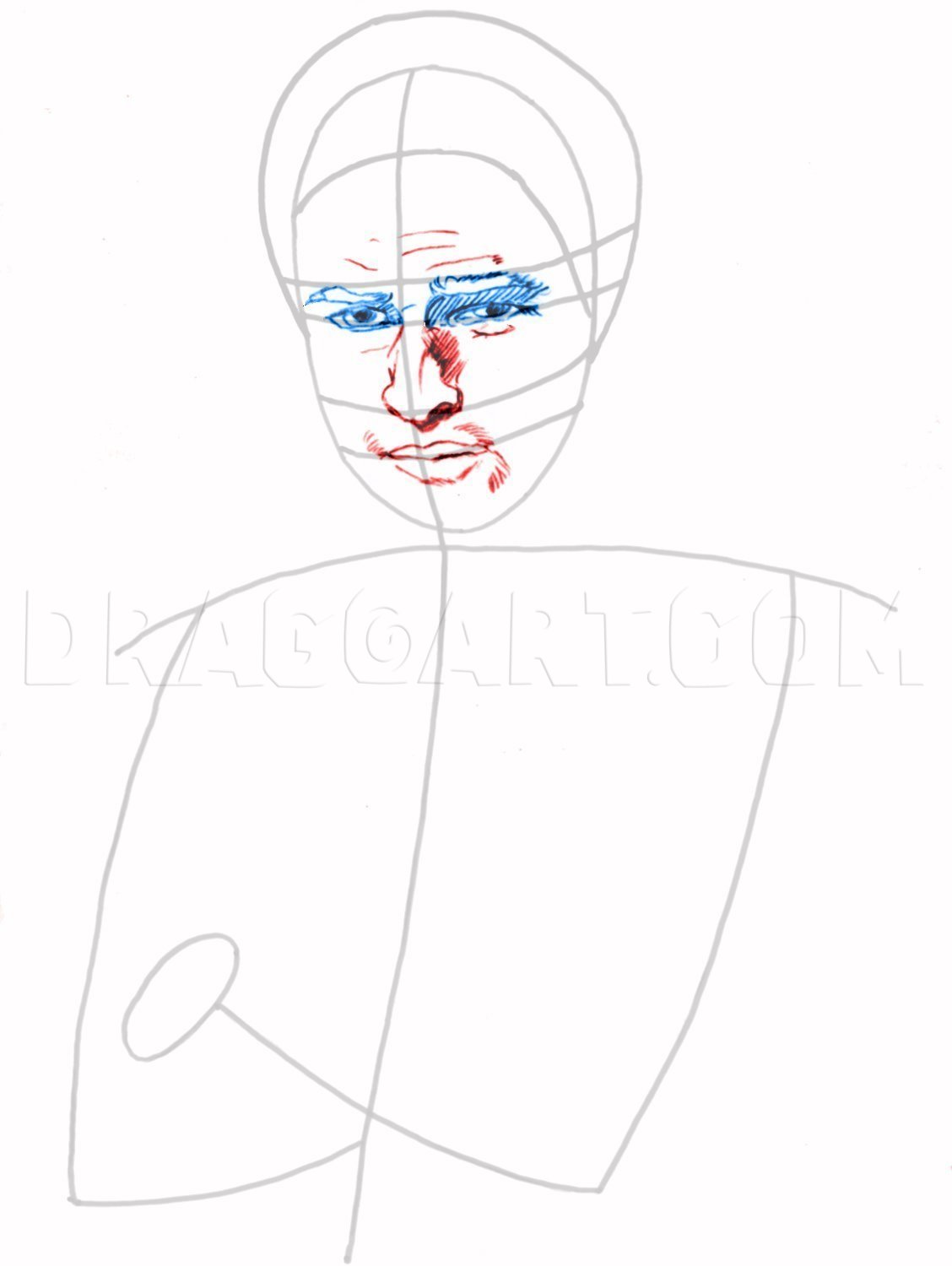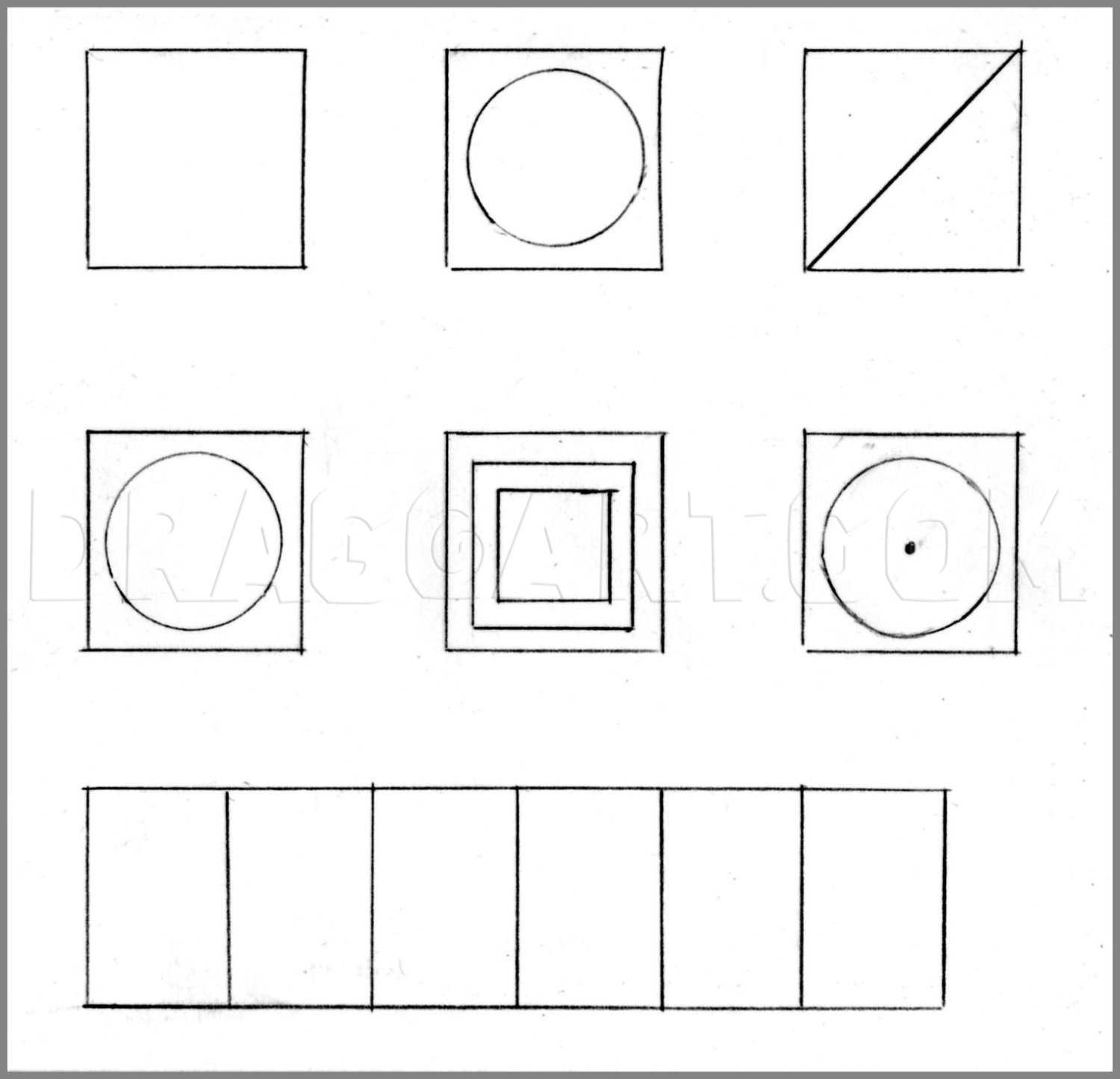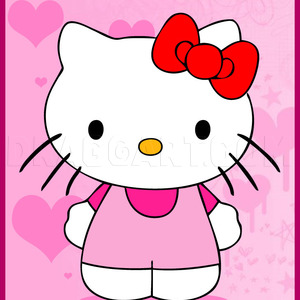1
First start with this oval for Marlon Brando's face. For his shoulders, draw the small hill. Draw the red lines representing his arms then the ovals for his for the portion of his hand. Of course, don't forget to bisect this guide with the line verti
2
The red crescent outer line is a placement for the crown of Mark's head. The crescent line inside his face represents his hairline. The a) line is for his eyebrows, b) line for his eyes, c) line for his nose, and d) line for his mouth
3
Draw in lightly his eyebrows and eyes. Compare to where they fall on the lines. Also check your drawing to see if it matches for accuracy.
4
Now draw lightly the wrinkles on his forehead, his nose, and mouth. Don't forget the crease at the side of his mouth.
6
Here is the fun part, that is drawing his mighty biceps. Gotta love it! Make sure you get those folds on his t-shirt! It tells you he's nicely built, pecs & all! Warning! Don't become impatient. That is your enemy. Take your time and focus on his han
7
Even if your picture doesn't look like this drawing, don't worry. We all have learning curves and I want to congratulate you on completing this tutorial thus far. Those of you who would like to continue, you know what to expect... a full pencil drawi
9
The picture that goes with this Step 9 shows two different ways to hold your pencil to acquire certain effects. OVERHAND: Holding a sharpened pencil in normal writing form with fingers in the middle or near the lead gives you great control and thin/d
10
PENCIL STROKES -- For your convenience, I have inserted this step with different pencils, strokes to use.
11
The picture here is a great exercise for value shading. I've got a little secret tip for you to make things easier. You can download this to your desktop. First click on the picture to have access to full size. By right clicking on your mouse, you ca
12
After printing out a number of the above template, practice shading in the values like this picture. You become familiar with this shading technique that gives you more control and confidence.
13
This time Acrylics or Opaque Watercolor has won! Sandpaper, the new kid on the block has to take a back seat. The texture on the wall behind Marlon Brando was created with a mixture of pencil, pastel, and kneaded eraser.
14
Click on the picture for helpful definitions TONE - SHADING - TEXTURE. Also a great way of identifying a way to start drawing on a blank page is determine what shape your subject is. The basic shapes of nature simplifies the drawing application.
15
Marlon Brando picture was taken with conventional lighting. Click on the LIGHTING picture for different ways to show off your subject.
16
This is the first start. This is where you would sketch in small circles or lines to shade the areas. It would take hours upon hours to cover all that area with a pencil. I chose to shade with pastels. In a few strokes I've got area coverage. Applied
18
First, I sketched in some more dark tones and details to his hair, face, and neck. I even included a bit more shading and detail to his hair and arms. At this point, I blended with my blending stump and then I sprayed. Marlon Brando is shaping up!
19
I darkened with some more 9B graphite and dark gray pastels. I have added some highlights to his hair and side of face. But after I scanned the picture and saw how milky dull it looked alongside the reference picture. I knew I had to go back to the d
20
Since the previous picture bothered me, I came back looked at the tone on my reference picture. I blackened his hair more (the spray had lightened it up) and darkened his facial areas, T-shirt, and the walls with a blending stump, 9B pencil and gray
21
Without highlights, your picture would have a flat appearance. Click on this picture to learn how to make your own picture POP out!
Comments 0
Details
January 26, 2012
Description: Marlon Brando, Jr. (April 3, 1924 – July 1, 2004) was an American movie star and political activist. Amazing! That's all I have to say about Marlon Brando. He actually was an activist, supporting many issues, notably the African-American Civil Rights Movement and various American Indian Movements.I also didn't know he was born in Omaha, Nebraska, where I lived for 9 years and met my husband. An enduring cultural icon, Brando became a box office star during the 1950s, during which time he racked up five Oscar nominations as Best Actor, along with three consecutive wins of the BAFTA Award for Best Actor in a Leading Role. He initially gained popularity for recreating the role as Stanley Kowalski in A Streetcar Named Desire (1951), a Tennessee Williams play that had established him as a Broadway star during its 1947-49 stage run; and for his Academy Award-winning performance as Terry Malloy in On the Waterfront (1954), as well as for his iconic portrayal of the rebel motorcycle gang leader Johnny Strabler in The Wild One (1953), which is considered to be one of the most famous images in pop culture. However, this tutorial is a homage to Brando. Also the drawing of him is his character role Stanley Kowalski in "A Streetcar Named Desire." That man had an animal magnetism one couldn't refuse. Just LOOK AT HIM! Buffed! I had to vent. However my peeps, if you enjoyed this tut, please let me know by a fav, vote, and comment. Love you all! Peace out!




















































































